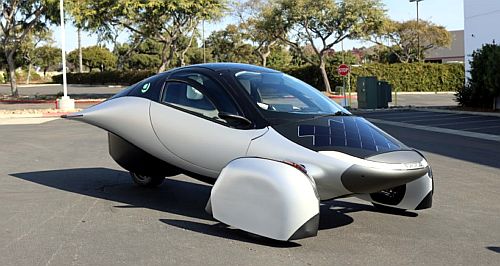Make / Model Search
News - General News - EventsCES 2025: Top auto revealsWild, wacky, and futuristic vehicle technology showcased at Consumer Electronics Show13 Jan 2025 THE annual Consumer Electronics Show (CES) was held in Las Vegas from 7-10 January, kicking off the year with a dizzying array of futuristic gadgets, technology and, of course, vehicles on show.
While some of the concepts on display, like Honda’s future ‘0’ electric vehicle range, have been shown before, there were several firsts like a three-wheeled solar-powered car, Hyundai’s sci-fi-esque holographic windscreen technology, and even a flying van (kind of).
The themes across the automotive offerings at CES were a mix of AI, new energy and, oddly, intercity air travel. Only a handful of manufacturers unveiled new and exciting technology but, among those who did, punters were given a look at what the future of urban mobility might look like.
Here are our top high-tech vehicle innovations from CES 2025, in no particular order.
Hip Hondas
Honda first introduced the world to its 0 Series EV range at last year’s CES event, with the Saloon and Space-Hub models representing a shift towards innovative new body styles.
At this year’s event Honda revealed additional details for the 0 Series Saloon and SUV, which were displayed in prototype form, confirming the models for 2026 with full Level 3 autonomous driving potential.
The design theme Honda has adopted is, ‘Thin, Light and Wise’, which the carmaker says challenges the conventional bulky EV aesthetic – flying in the face of the ‘add more’ approach to modern vehicles.
“The mobility we dream of is not an extension of the trend of ‘thick, heavy, but smart’ EVs,” said Honda global chief executive Toshihiro Mibe.
“We will create a completely new value from zero based on thin, light and wise as the foundation for our new Honda 0 EV series to further advance the joy and freedom of mobility to the next level.”
The ‘wise’ element of the equation comes in the form of Level 3 automated driving technology, alongside Honda’s new vehicle operating system, the ASIMO OS, which will be installed in 0 Series vehicles.
ASIMO was Honda’s early 2000s humanoid robot, with the new operating system aiming to achieve a similar level of human integration – controlling automated driving systems, in-vehicle infotainment, and various other electronic functions.
Powertrain details and critical factors like driving range are yet to be confirmed, but Honda did outline a new ‘attitude estimation and stabilisation’ system that will use 3D gyro sensors borrowed from the brand’s robotics technologies.
Honda also debuted a new H mark logo that will be exclusively used on its next-generation EVs, starting with the 0 Series models.
Bavarian Vision
BMW premiered its new iDrive user experience system, which will be featured in the brand’s next-generation Neue Klasse range of electric vehicles, with a new Panoramic Vision heads-up display stealing the spotlight.
The Panoramic Vision head-up display, which spans from A-pillar to A-pillar, reflects visible information onto a black surface in the lower section of the windscreen, making it visible to all occupants.
An optional 3D head-up display above the Panoramic Vision area will show additional navigation and automated driving information, meaning a Neue Klasse model could in fact have two stacked head-up displays.
The new iDrive system also features a central display with matrix backlight technology, and a multifunction steering wheel.
“High tech meets highly intuitive operation – a quarter of a century of pioneering work and technological leadership in operating concepts has been channelled into the new BMW Panoramic iDrive,” said BMW AG boardmember Frank Weber.
“The foundations are provided by the new BMW Operating System X. With this advance, we are giving one of the world’s best and most comprehensive infotainment systems even greater capability and once again setting the industry benchmark in multimodal interaction.”
At its core is BMW’s new Operating System X, developed entirely in-house based on an Android Open Source Project (AOSP) software stack, capable of powering the various iDrive features. BMW’s new AI-powered Intelligent Personal Assistant will also get smarter, apparently even prompting drivers to engage sports mode on certain routes.
Now that’s AI we can get behind!
Holographic Hyundai
Hyundai Mobis seemingly one-upped BMW’s Panoramic Vision, unveiling a holographic head-up display that covers much of the windscreen – and it looks like something straight out of a video game.
Not to be mistaken for the carmaker, Hyundai Mobis is a global automotive supplier that produces parts for Hyundai and Kia – akin to Denso which supplies Toyota and other Japanese OEMs, or ZF which supplies various German players.
The company showcased its new holographic head-up display in a Kia EV9 at CES, effectively transforming the windscreen into a blank canvas on which it can project an array of information, images and even video.
According to Hyundai Mobi, the secret sauce, which it developed alongside German optical specialist Zeiss, is a special film on the windscreen that contains a Holographic Optical Element (HOE) and uses light diffraction.
This allows the windscreen to appear transparent, while offering crystal clear visuals and high brightness even in sunny conditions – complete with a privacy mode.
Pre-development of the holographic technology is expected to be completed by mid-2025, with Hyundai Mobis planning to launch the system by 2027.
XPeng sky-high
Xpeng AeroHT, the aerospace company majority-owned by Chinese carmaker Xpeng, shot for the stars at CES unveiling its Land Aircraft Carrier – a mothership that combines an electric six-wheeled van and electric vertical take-off and landing (eVTOL) vehicle.
The company is calling the Xpeng Aero HT a modular flying car, but it looks more like an extended-wheelbase Cybertruck with a giant human-carrying drone in the boot – and the car itself never leaves the ground, just to clarify.
Who would possibly buy one? Well, Xpeng AeroHT claims the Land Aircraft Carrier is designed for intercity commuters, offering high-speed, low-altitude air travel.
While the Land Aircraft Carrier might look like an inoperable concept, it completed its first public flight at the China International Airshow in November last year and the company is gearing up to mass produce the mothership.
According to XPeng AeroHT, its manufacturing facility in Guangzhou, China, is scheduled to be finished in Q3 this year, with deliveries set to begin in 2026.
Solar sensation
US-based startup Aptera debuted its production-ready solar electric vehicle (sEV) at CES, showcasing a three-wheeled car that can add 64km of driving range per day from solar power alone.
The sEV uses four solar panels equalling 700W and a lightweight carbon fibre body, offering a battery range of 643km after an hour of charging and additional range as solar power is harvested.
Being a pre-production model, specifics are light-on, but the company’s website states the model uses just 100Wh per mile and can complete the 0-100km/h sprint in around six seconds.
According to Aptera, the company has amassed nearly 50,000 reservations but the vehicle’s production and launch dates are yet to be confirmed.
 Read more16th of January 2024  VinFast CES success spurs Aussie design houseGomotiv flying Aussie flag on world stage for full vehicle concept and production work |
Click to shareGeneral News articlesMotor industry news |











Facebook Twitter Instagram